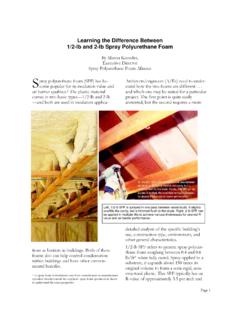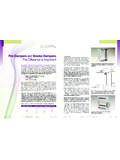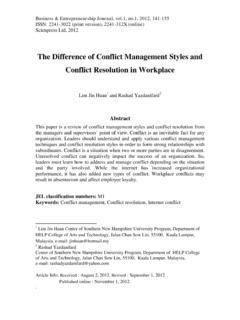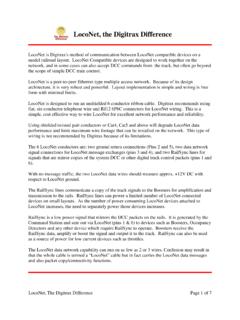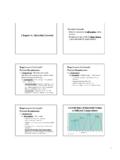Transcription of The Difference between Type 6,6 and Type 6 Nylon …
1 1 | P a g e K02510. Revised Property of INVISTA. Not to be copied, reproduced, distributed or edited in whole or in part. 2013 INVISTA. All Rights Reserved. Antron and the Antron family of marks and logos are trademarks of INVISTA. The Difference between type 6 ,6 and type 6 Nylon In the 1930s, a new class of synthetic polymer called polyamides was invented, more commonly known as Nylon . There are several types of Nylon polymers. The most widely utilized polyamides in commerce are type 6 ,6 Nylon and type 6 Nylon .
2 type 6 ,6 Nylon was chosen for carpet fibers because it was believed to provide exceptional resistance to crushing and matting, heat and friction, and stain penetration. More than 70 years later, INVISTA continues to use type 6 ,6 Nylon as the foundation for Antron carpet fiber. Although type 6 ,6 Nylon and type 6 Nylon have the same ratios of carbon, hydrogen, oxygen, and nitrogen atoms, they begin with different polymer building blocks or monomers. The type 6 monomer, caprolactam, polymerizes in a head-to-tail fashion.
3 type 6 ,6 Nylon begins with hexamethylene diamine and adipic acid which alternate to form the polyamide. The different building blocks (monomers) drive the differences in polymer structure and physical properties between type 6 ,6 Nylon and type 6 Nylon . More Favorable Hydrogen Bonding An important type of molecular interaction in Nylon is hydrogen bonding, which contributes substantially to polymer properties. It turns out that the arrangement of atoms for type 6 ,6 Nylon allows for more favorable hydrogen bonding than type 6 Nylon .
4 type 6 Nylon polymer has two ways to align and in ~50% of its alignments has skewed hydrogen bonds that are longer and weaker. There is only one way for hydrogen bonds to align for type 6 ,6 Nylon . In type 6 ,6 Nylon , the hydrogen bonds directly line up creating a strong, dense polymer structure. By virtue of their numbers, hydrogen bonds can present a significant barrier to polymer deformation; , in order to permanently deform such a fiber, a large number of hydrogen bonds have to be broken. type 6 ,6 Nylon has on average stronger, shorter hydrogen bonds giving it a tighter, more dense polymer structure than type 6 Nylon .
5 The stronger the hydrogen bonds, the more heat or mechanical energy required to break them; type 6 ,6 Nylon melts at a temperature that is more than 40 C (70 F) higher than type 6 Nylon . An extreme example of the importance of hydrogen bonding is polypropylene (olefin) which has no hydrogen bonding, which is a key reason that it readily deforms and does not recover from compression as well as Nylon . More Highly Ordered Both type 6 ,6 Nylon and type 6 Nylon are semi-crystalline polymers. This refers to the way the polymer chains pack together with some regions that are highly ordered, while others are amorphous (less ordered).
6 Under similar processing conditions, type 6 ,6 Nylon is more crystalline and ordered than type 6 Nylon resulting in differentiated physical properties such as greater resilience/recovery after compression, higher melting point and slower permeability. Texture Retention Benefit Both nylons have excellent recovery properties in carpet versus polypropylene and polyester. However, with a more-ordered structure and on average stronger hydrogen bonding, type 6 ,6 Nylon carpets can perform better than equivalently constructed carpets of type 6 Nylon .
7 2 | P a g e K02510. Revised Property of INVISTA. Not to be copied, reproduced, distributed or edited in whole or in part. 2013 INVISTA. All Rights Reserved. Antron and the Antron family of marks and logos are trademarks of INVISTA. Higher Melting Point type 6 ,6 Nylon melts at 255-265 C (490-510 F), type 6 Nylon melts at 210-220 C (410-428 F), and polypropylene melts at 160-175 C (320-347 F). Neither Nylon is especially susceptible to melting associated with frictional heat (such as the heat generated at the leg end when a table is dragged across the floor) as is the case with polypropylene.
8 Heat Resistance Benefit The much higher melting point of type 6 ,6 Nylon gives it a substantially greater safety margin for recovery from contact with hot objects. A higher melting point also provides resistance to frictional heating and its negative effect on wear performance. Lower Permeability type 6 ,6 Nylon with its tighter, more dense, more ordered polymer structure retards stain penetration due to lower permeability than type 6 Nylon . Lower Stain Permeability Benefit Lower permeability means that stains diffuse more slowly into type 6 ,6 Nylon so there may be more time to clean up a spill before it becomes a stain.
9 In addition to the benefits attributed to type 6 ,6 Nylon polymer alone, INVISTA s advanced fiber engineering combined with type 6 ,6 Nylon polymer gives Antron Nylon the following performance differences compared to carpets of type 6 Nylon . The Antron Brand Advantage Carpets of Antron Lumena solution dyed Nylon typically have 2x better stain resistance and can have better stain resistance than carpets of type 6 solution dyed Nylon *. Enhanced Stain Resistance INVISTA uses an advanced manufacturing technology to give Antron Lumena solution dyed Nylon inherent acid-dye stain resistance (like most foods and beverages) that will hold up to commercial carpet cleanings and very high levels of foot traffic.
10 Carpets of Antron Lumena solution dyed Nylon can have 40% better colorfastness to light, household bleach and atmospheric contaminants compared to carpets of type 6 solution dyed Nylon *. Enhanced Colorfastness Each color of Antron Lumena Nylon is developed by INVISTA to provide outstanding color fastness to light, household bleach and atmospheric contaminants. Carpets of Antron Nylon can last 60% longer than carpets of type 6 Nylon *. Enhanced Texture Retention When a carpet retains its appearance longer, it will stay newer looking longer and its usable life may be extended.
